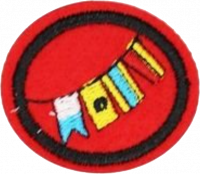Difference between revisions of "AY Honors/Nautical Flags/Answer Key"
From Pathfinder Wiki
< AY Honors | Nautical FlagsAY Honors/Nautical Flags/Answer Key
(Created page with "<languages /><br /> <translate> {{honor_desc |stage=00 |honorname=Nautical Flags |skill=2 |year=2012 |category=Vocational |authority=South American Division |insignia=Nautical...") |
(Marked this version for translation) |
||
| (8 intermediate revisions by 3 users not shown) | |||
| Line 1: | Line 1: | ||
| − | < | + | {{HonorSubpage}} |
| − | + | <section begin="Body" /> | |
| − | {{ | + | {{ansreq|page={{#titleparts:{{PAGENAME}}|2|1}}|num=1}} |
| − | | | + | <noinclude><translate><!--T:9--> |
| − | | | + | </noinclude> |
| − | | | + | <!-- 1. Why does the International Code of Signals (ICS) exist, what does it do and where is it used? --> |
| − | | | ||
| − | |||
| − | |||
| − | |||
| − | == | + | <!--T:10--> |
| + | <noinclude></translate></noinclude> | ||
| + | {{CloseReq}} <!-- 1 --> | ||
| + | {{ansreq|page={{#titleparts:{{PAGENAME}}|2|1}}|num=2}} | ||
| + | <noinclude><translate><!--T:11--> | ||
| + | </noinclude> | ||
| + | <!-- 2. Know the meaning of a pennon. --> | ||
| − | == | + | <!--T:12--> |
| + | <noinclude></translate></noinclude> | ||
| + | {{CloseReq}} <!-- 2 --> | ||
| + | {{ansreq|page={{#titleparts:{{PAGENAME}}|2|1}}|num=3}} | ||
| + | <noinclude><translate><!--T:13--> | ||
| + | </noinclude> | ||
| + | <!-- 3. Through drawings or pictures, make a table displaying nautical flags and their meanings, signs, letters and numbers, as well as the message that flag transmits when displayed by itself. --> | ||
| − | == | + | <!--T:14--> |
| + | <noinclude></translate></noinclude> | ||
| + | {{CloseReq}} <!-- 3 --> | ||
| + | {{ansreq|page={{#titleparts:{{PAGENAME}}|2|1}}|num=4}} | ||
| + | <noinclude><translate><!--T:15--> | ||
| + | </noinclude> | ||
| + | <!-- 4. Demonstrate ten examples of combinations of nautical flags. --> | ||
| − | == | + | <!--T:16--> |
| + | <noinclude></translate></noinclude> | ||
| + | {{CloseReq}} <!-- 4 --> | ||
| + | {{ansreq|page={{#titleparts:{{PAGENAME}}|2|1}}|num=5}} | ||
| + | <noinclude><translate><!--T:17--> | ||
| + | </noinclude> | ||
| + | <!-- 5. Identify the four substitute cornets and their uses. --> | ||
| − | == | + | <!--T:18--> |
| + | <noinclude></translate></noinclude> | ||
| + | {{CloseReq}} <!-- 5 --> | ||
| + | {{ansreq|page={{#titleparts:{{PAGENAME}}|2|1}}|num=6}} | ||
| + | <noinclude><translate><!--T:19--> | ||
| + | </noinclude> | ||
| + | <!-- 6. Maintain a conversation between two groups, using nautical flags, indicating their single and summed meanings with a minimum distance of 300 meters between the two groups. --> | ||
| − | + | <!--T:20--> | |
| − | + | <noinclude></translate></noinclude> | |
| − | ==References== | + | {{CloseReq}} <!-- 6 --> |
| − | </translate> | + | <noinclude><translate></noinclude> |
| + | ==References== <!--T:8--> | ||
| + | [[Category:Adventist Youth Honors Answer Book|{{SUBPAGENAME}}]] | ||
| + | <noinclude></translate></noinclude> | ||
| + | {{CloseHonorPage}} | ||
Latest revision as of 16:07, 13 May 2021
1
Why does the International Code of Signals (ICS) exist, what does it do and where is it used?
2
Know the meaning of a pennon.
3
Through drawings or pictures, make a table displaying nautical flags and their meanings, signs, letters and numbers, as well as the message that flag transmits when displayed by itself.
4
Demonstrate ten examples of combinations of nautical flags.
5
Identify the four substitute cornets and their uses.
6
Maintain a conversation between two groups, using nautical flags, indicating their single and summed meanings with a minimum distance of 300 meters between the two groups.



